Digital Academic Leadership in Higher Education Institutions: A Bibliometric Review Based on CiteSpace
Abstract
1. Introduction
- i.
- What are the hotspot areas of digital academic leadership in higher education institutions?
- ii.
- What has been published on the topic of digital academic leadership, focusing on authors, institutions, and countries?
- iii.
- What are the development trends of digital academic leadership within the context of digital transformation in higher education institutions?
2. Literature Review
2.1. Conceptual Foundations of Digital Leadership
2.2. Competency Frameworks and Practical Applications
2.3. Social and Network Dimensions
2.4. Strategic and Organizational Perspectives
2.5. Integration and Future Orientation
3. Materials and Methods
3.1. Data Source and Search Strategy
3.2. Data Was Collected Using the Following Search Strategy
- Select: Web of Science Core Collection: Science Citation Index Expanded (SCIE) and Social Science Citation Index (SSCI) as the data source.
- Topic: ((*Digital academic leadership*) OR (*digital leadership*) OR (*electronic academic leadership*)) AND (*higher education institution*) AND (*digital transformation*).
- Language: *English*.
- Period: *2014–2024*.
- Index date: *2014*present.
- Document type: *Article* or *review* and *book chapter* and *proceeding paper*.
- Statistical analysis: This analysis examined the temporal distribution of publications in the field of digital academic leadership and categorized these publications. By analyzing statistical characteristics, insights into the knowledge foundation of research on digital academic leadership were gained.
- Collaboration analysis: This analysis focused on collaboration networks among institutions, regions, and authors, providing a multi-faceted view of the correlations within the field of digital academic leadership.
- Co-citation analysis: By analyzing co-cited networks among journals, references, and authors, insights into the current state of research evolution in the field of digital academic leadership were obtained.
- Co-occurrence analysis: Networks of co-occurring keywords were analyzed to identify potential hotspots and future trends in digital academic leadership research.
- Building a comprehensive knowledge framework: This process helped scholars quickly understand the comprehensive knowledge and logical structure that form the basis of digital academic leadership research from different perspectives.
3.3. Bibliometric Data Analysis
3.4. Utilization of CiteSpace for Data Analysis
3.5. Document Selection and Network Construction
- Time slicing: 2014–2024, with 1 year per slice.
- Node type: Reference.
- Selection criteria per slice 10: Top 50 documents using g-index (k = 24).
- Link reduction: Pathfinder.
- Pruning: None (to preserve structure for interpretation).
3.6. Justification for Using CiteSpace with a Small Set
3.6.1. Identification of Intellectual Structure and Key Trends
3.6.2. Rigorous and Transparent Selection
3.7. Potential Impact of Document Selection on Trends
4. Results of Bibliometric Analyses Using CiteSpace for Digital Academic Leadership
4.1. Contextual Interpretation of Document Selection and Network Structure
4.2. Temporal Distribution of Publications
5. Discussion
5.1. Evolving Landscape of Digital Academic Leadership
5.2. Thematic Clustering and Research Priorities
5.3. Geographical and Institutional Contributions
5.4. Implications for Research and Practice
6. Limitations and Future Research
7. Conclusions
Author Contributions
Funding
Conflicts of Interest
References
- Abramo, G., D’Angelo, C. A., Di Costa, F., & Solazzi, M. (2011). The role of information asymmetry in the market for university-industry research collaboration. The Journal of Technology Transfer, 36(1), 84–100. [Google Scholar] [CrossRef]
- Ahlquist, J. (2016). Trending now: Digital leadership education using social media and the social change model. Journal of Leadership Studies, 8(2), 57–60. [Google Scholar] [CrossRef]
- Aldawood, H., Alhejaili, A., Alabadi, M., Alharbi, O., & Skinner, G. (2019, July 8–11). Integrating digital leadership in an educational supervision context: A critical appraisal. 2019 International Conference in Engineering Applications (ICEA), Azores Island, Portugal. [Google Scholar] [CrossRef]
- Antonopoulou, H., Halkiopoulos, C., Barlou, O., & Beligiannis, G. N. (2020). Leadership types and digital leadership in higher education: Behavioural data analysis from University of Patras in Greece. International Journal of Learning, Teaching and Educational Research, 19(4), 110–129. [Google Scholar] [CrossRef]
- Arnold, N., & Paulus, T. (2010). Using a social networking site for experiential learning: Appropriating, lurking, modeling and community building. Internet and Higher Education, 13(4), 188–196. [Google Scholar] [CrossRef]
- Avolio, B. J., Sosik, J. J., Kahai, S. S., & Baker, B. (2014). E-leadership: Re-examining transformations in leadership source and transmission. The Leadership Quarterly, 25(1), 105–131. [Google Scholar] [CrossRef]
- Bates, A. W. (2015). Teaching in a digital age: Guidelines for designing teaching and learning. Tony Bates Associates Ltd. [Google Scholar]
- Benavides, L. M. C., Tamayo Arias, J. A., Arango Serna, M. D., Branch Bedoya, J. W., & Burgos, D. (2020). Digital transformation in higher education institutions: A systematic literature review. Sensors, 20(11), 3291. [Google Scholar] [CrossRef]
- Benitez, J., Arenas, A., Castillo, A., & Esteves, J. (2022). Impact of digital leadership capability on innovation performance: The role of platform digitization capability. Information & Management, 59(2), 103590. [Google Scholar]
- Blakeman, K. (2018). Bibliometrics in a digital age: Help or hindrance. Science Progress, 101(3), 293–310. [Google Scholar] [CrossRef]
- Borah, P. S., Iqbal, S., & Akhtar, S. (2022). Linking social media usage and SME’s sustainable performance: The role of digital leadership and innovation capabilities. Technology in Society, 68, 101900. [Google Scholar] [CrossRef]
- Brown, C., Czerniewicz, L., Mayisela, T., & Huang, C. W. (2016, November 27–30). A practice-based approach to theorising digital education leadership (Concept paper). Eighth Pan-Commonwealth Forum, Lumpur, Malaysia. [Google Scholar]
- Brown, L. (2014). Best practices of leadership in educational technology. Journal of Educational Technology, 11(1), 1–6. Available online: https://files.eric.ed.gov/fulltext/EJ1098558.pdf (accessed on 26 June 2025). [CrossRef]
- Chen, C. (2006). CiteSpace II: Detecting and visualizing emerging trends and transient patterns in scientific literature. Journal of the American Society for information Science and Technology, 57, 359–377. [Google Scholar] [CrossRef]
- Cheng, Z., Dinh, N. B. K., Caliskan, A., & Zhu, C. (2024, December 12). Dimensions of digital academic leadership in higher education: A systematic review. International Conference ALTA (Vol. 23, pp. 63–68), Lithuania, LA, USA. [Google Scholar]
- Clark, W. R., Clark, L. A., Raffo, D. M., & Williams, R. I. (2021). Extending fisch and block’s (2018) tips for a systematic review in management and business literature. Management Review Quarterly, 71, 215–231. [Google Scholar] [CrossRef]
- Cortellazzo, L., Bruni, E., & Zampieri, R. (2019). The role of leadership in a digitalized world: A review. Frontiers in Psychology, 10, 1938. [Google Scholar] [CrossRef] [PubMed]
- Couros, G. (2013, January 7). Digital leadership defined. George Couros. Available online: https://georgecouros.ca/blog/archives/3584 (accessed on 26 June 2025).
- Cretu, D. M., & Grosseck, G. (2025). A bibliometric analysis of romanian educational research in web of science: Trends, challenges, and opportunities for global integration. Education Sciences, 15(3), 358. [Google Scholar] [CrossRef]
- Domeny, J. V. (2017). The relationship between digital leadership and digital implementation in elementary schools [Unpublished doctoral dissertation, Southwest Baptist University]. [Google Scholar]
- Donthu, N., Kumar, S., Mukherjee, D., Pandey, N., & Lim, W. M. (2021). How to conduct a bibliometric analysis: An overview and guidelines. Journal of Business Research, 133, 285–296. [Google Scholar] [CrossRef]
- Erhan, T., Uzunbacak, H. H., & Aydin, E. (2022). From conventional to digital leadership: Exploring digitalization of leadership and innovative work behavior. Management Research Review, 45(11), 1524–1543. [Google Scholar] [CrossRef]
- Goh, J. M., & Arenas, A. E. (2020). IT value creation in public sector: How IT-enabled capabilities mitigate tradeoffs in public organisations. European Journal of Information Systems, 29(1), 25–43. [Google Scholar] [CrossRef]
- Govender, D. W., & Jugernath, J. (2017). Digital learning and digital leadership for digital citizenship in a digital age. Journal of Social Sciences, 51(3), 111–122. [Google Scholar]
- Gusenbauer, M., & Haddaway, N. R. (2020). Which academic search systems are suitable for systematic reviews or meta-analyses? Evaluating retrieval qualities of Google Scholar, PubMed, and 26 other resources. Research Synthesis Methods, 11(2), 181–217. [Google Scholar] [CrossRef]
- Hamzah, N. H., Nasir, M. K. M., & Wahab, J. A. (2021). The effects of principals’ digital leadership on teachers’ digital teaching during the COVID-19 pandemic in Malaysia. Journal of Education and E-Learning Research, 8(2), 216–221. [Google Scholar] [CrossRef]
- Hérubel, J. P. V. (1999). Historical bibliometrics: Its purpose and significance to the history of disciplines. Libraries & Culture, 34(4), 380–388. [Google Scholar]
- Hou, J., & Hu, Z. (2019). Review on the application of Citespace at home and abroad. Journal of Modern Information, 33, 99–103. Available online: https://www.webofscience.com/wos/woscc/summary/db7ecc97-fe3e-40ba-936e-95caf1ebe1df-0108208d85/relevance/1 (accessed on 26 June 2025).
- Ifelebuegu, A. O., Kulume, P., & Cherukut, P. (2023). Chatbots and AI in Education (AIEd) tools: The good, the bad, and the ugly. Journal of Applied Learning and Teaching, 6(2), 332–345. [Google Scholar]
- Jameson, J., Rumyantseva, N., Cai, M., Markowski, M., Essex, R., & McNay, I. (2022). A systematic review and framework for digital leadership research maturity in higher education. Computers and Education Open, 3, 100115. [Google Scholar] [CrossRef]
- Jansen van Vuuren, C. D., Visser, K., & Du Plessis, M. (2021). Contemporary leadership behaviour enabling leadership effectiveness in a public university [Doctoral thesis, University of the Western Cape]. [Google Scholar]
- Kane, G. C., Phillips, A. N., Copulsky, J., & Andrus, G. (2019). How digital leadership is (n’t) different. MIT Sloan Management Review, 60(3), 34–39. [Google Scholar]
- Karakose, T., Kocabas, I., Yirci, R., Papadakis, S., Ozdemir, T. Y., & Demirkol, M. (2022). The development and evolution of digital leadership: A bibliometric mapping approach-based study. Sustainability, 14(23), 16171. [Google Scholar] [CrossRef]
- Keengwe, J., & Anyanwu, C. N. (2017). Digital leadership in higher education: Preparing for the fourth industrial revolution. International Journal of Information and Learning Technology, 34(5), 410–412. [Google Scholar]
- Kokot, K., Kokotec, I. Đ., & Čalopa, M. K. (2023). Digital leadership and maturity as a key to successful digital transformation: Country case study of Croatia. TEM Journal, 12(1), 192–199. [Google Scholar] [CrossRef]
- Lin, K. H., Mo, S., Klingher, B., Mu, F., & Zhou, B. (2024). Ctrl-x: Controlling structure and appearance for text-to-image generation without guidance. Advances in Neural Information Processing Systems, 37, 128911–128939. [Google Scholar]
- Liu, X., Liu, N., Zhou, M., Lu, Y., & Li, F. (2018). Bibliometric analysis of global research on the rehabilitation of spinal cord injury in the past two decades. Therapeutics and Clinical Risk Management, 15, 1–14. [Google Scholar] [CrossRef]
- Lu, Y. (2017). Industry 4.0: A survey on technologies, applications and open research issues. Journal of Industrial Information Integration, 6, 1–10. [Google Scholar] [CrossRef]
- Mao, G., Shi, T., Zhang, S., Crittenden, J., Guo, S., & Du, H. (2018). Bibliometric analysis of insights into soil remediation. Journal of Soils and Sediments, 18(7), 2520–2534. [Google Scholar] [CrossRef]
- Marczewska, M., Weresa, M. A., & Lachowicz, M. (2024). Towards creativity and innovation in universities: Study on central and eastern Europe. Journal of the Knowledge Economy, 15(1), 1363–1385. [Google Scholar] [CrossRef]
- Mayr, P., & Scharnhorst, A. (2015). Scientometrics and information retrieval: Weak-links revitalized. Scientometrics, 102, 2193–2199. [Google Scholar] [CrossRef]
- McGonagill, G., & Doerffer, T. (2011). Leadership and web 2.0: The leadership implications of the evolving web. Bertelsmann Stiftun. [Google Scholar]
- Mihajlo, M., Vuk, A., Rosanda, I., Vuk, S., Aleksandar, S., Aleksandra, P., Marina, M., Zarko, N., Sacco, M., & Danica, G. (2019). Spontaneous cerebrospinal fluid rhinorrhea in a patient with Pallister–Hall syndrome. Romanian Neurosurgery, 33(3), 305–309. [Google Scholar] [CrossRef]
- Nyahodza, L., & Higgs, R. (2017). Towards bridging the digital divide in post-apartheid South Africa: A case of a historically disadvantaged university in Cape Town. South African Journal of Libraries and Information Science, 83(1), 39–48. [Google Scholar] [CrossRef]
- Orcutt, J. M., & Dringus, L. P. (2017). Beyond being there: Practices that establish presence, engage students and influence intellectual curiosity in a structured online learning environment. Online Learning Journal, 21(3), 15–35. [Google Scholar] [CrossRef]
- Rębisz, S., & Lungulov, B. (2022). Education scholars from Eastern Europe in the digital environment: A comparative study of selected universities from Poland, Slovakia, Hungary, and Serbia. Annals of Library and Information Studies (ALIS), 69(3), 238–251. [Google Scholar]
- Sambamurthy, V., Bharadwaj, A., & Grover, V. (2003). Shaping agility through digital options: Reconceptualizing the role of information technology in contemporary firms. MIS Quarterly: Management Information Systems, 27(2), 237–264. [Google Scholar] [CrossRef]
- Shafique, M. (2013). Thinking inside the box? Intellectual structure of the knowledge base of innovation research (1988–2008). Strategic Management Journal, 34(1), 62–93. [Google Scholar] [CrossRef]
- Sheninger, E. (2019). Digital leadership: Changing paradigms for changing times. Corwin Press. [Google Scholar]
- Snyder, H. (2019). Literature review as a research methodology: An overview and guidelines. Journal of Business Research, 104, 333–339. [Google Scholar] [CrossRef]
- Tuerk-Stonberg, J., & Bardzik, J. (2023). Epigraphy, image, and material: The strategic power of the word “and” on byzantine uterine amulets. Magic, Ritual, and Witchcraft, 18(3), 333–363. [Google Scholar] [CrossRef]
- Vial, S. (2019). Being and the screen: How the digital changes perception. Published in one volume with a short treatise on design. MIT Press. [Google Scholar]
- Wang, W., & Lu, C. (2020). Visualization analysis of big data research based on Citespace. Soft Computing, 24(11), 8173–8186. [Google Scholar] [CrossRef]
- Wang, Z., Qi, F., Liu, L., Chen, M., Sun, D., & Nan, J. (2021). How do urban rainfall-runoff pollution control technologies develop in China? A systematic review based on bibliometric analysis and literature summary. Science of the Total Environment, 789, 148045. [Google Scholar] [CrossRef] [PubMed]
- Wild, J., van der Merwe, M., & Stacey, E. (2019). Leadership in a digital age: Developing digital and distributed leadership in South African higher education. British Journal of Educational Technology, 50(3), 1180–1195. [Google Scholar]
- Wu, L., Wang, W., Jing, P., Chen, Y., Zhan, F., Shi, Y., & Li, T. (2020). Travel mode choice and their impacts on environment—A literature review based on bibliometric and content analysis, 2000–2018. Journal of Cleaner Production, 249, 119391. [Google Scholar] [CrossRef]
- Wu, Y., Wang, H., Wang, Z., Zhang, B., & Meyer, B. C. (2019). Knowledge mapping analysis of rural landscape using CiteSpace. Sustainability, 12, 66. [Google Scholar] [CrossRef]
- Zeike, S., Bradbury, K., Lindert, L., & Pfaff, H. (2019). Digital leadership skills and associations with psychological well-being. International Journal of Environmental Research and Public Health, 16(14), 2628. [Google Scholar] [CrossRef]
- Zhong, L. (2016). The effectiveness of digital leadership at K-12 schools in Mississippi regarding communication and collaboration during CCRS implementation. The University of Southern Mississippi. [Google Scholar]
- Zou, S., Glynn, S. A., Makani, J., Tayou Tagny, C., El Ekiaby, M., Sabino, E. C., Choudhury, N., Teo, D., Nelson, K., Peprah, E., Price, L., & Engelgau, M. M. (2018). Addressing gaps in international blood availability and transfusion safety in low-and middle-income countries: A NHLBI workshop. Transfusion, 58(5), 1307–1317. [Google Scholar]
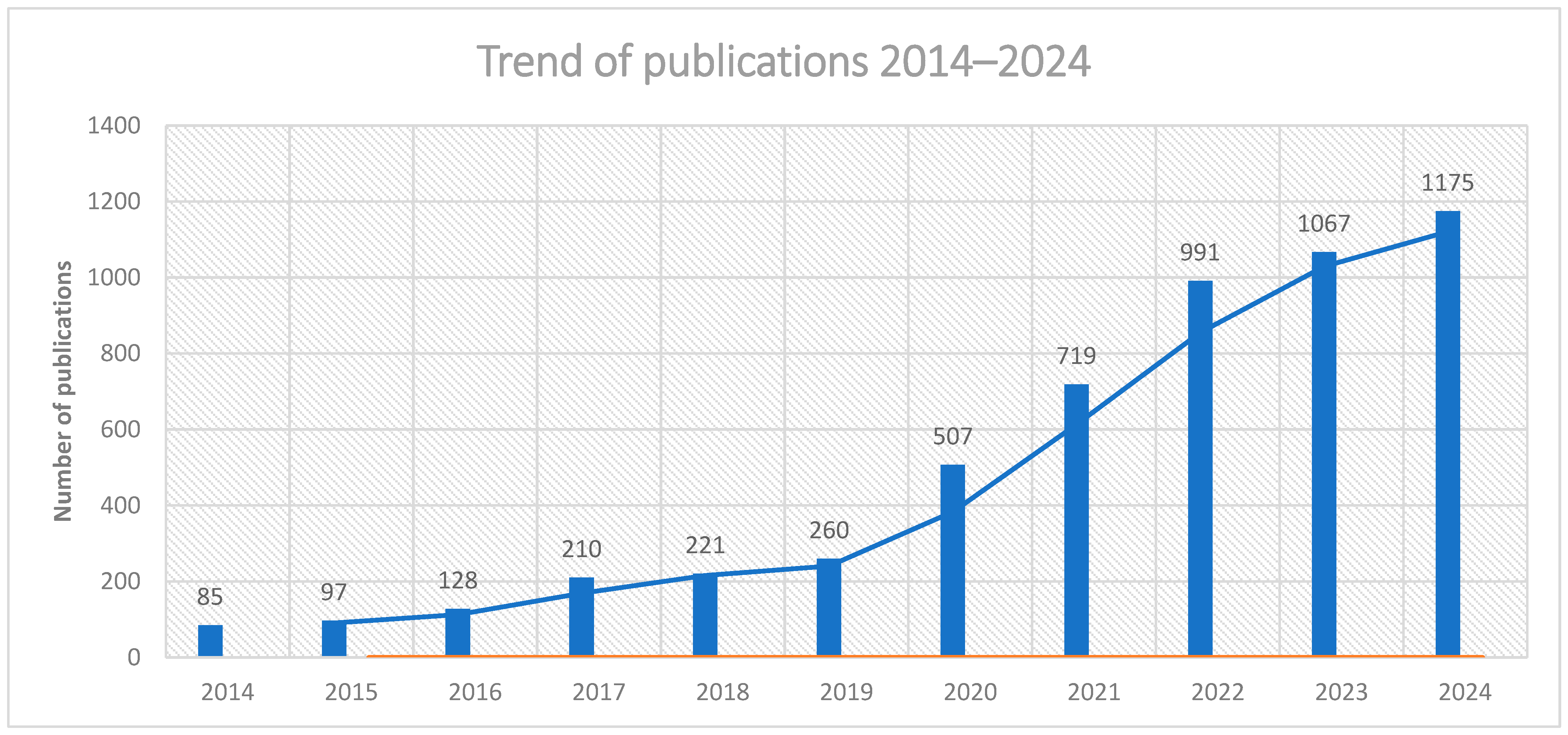
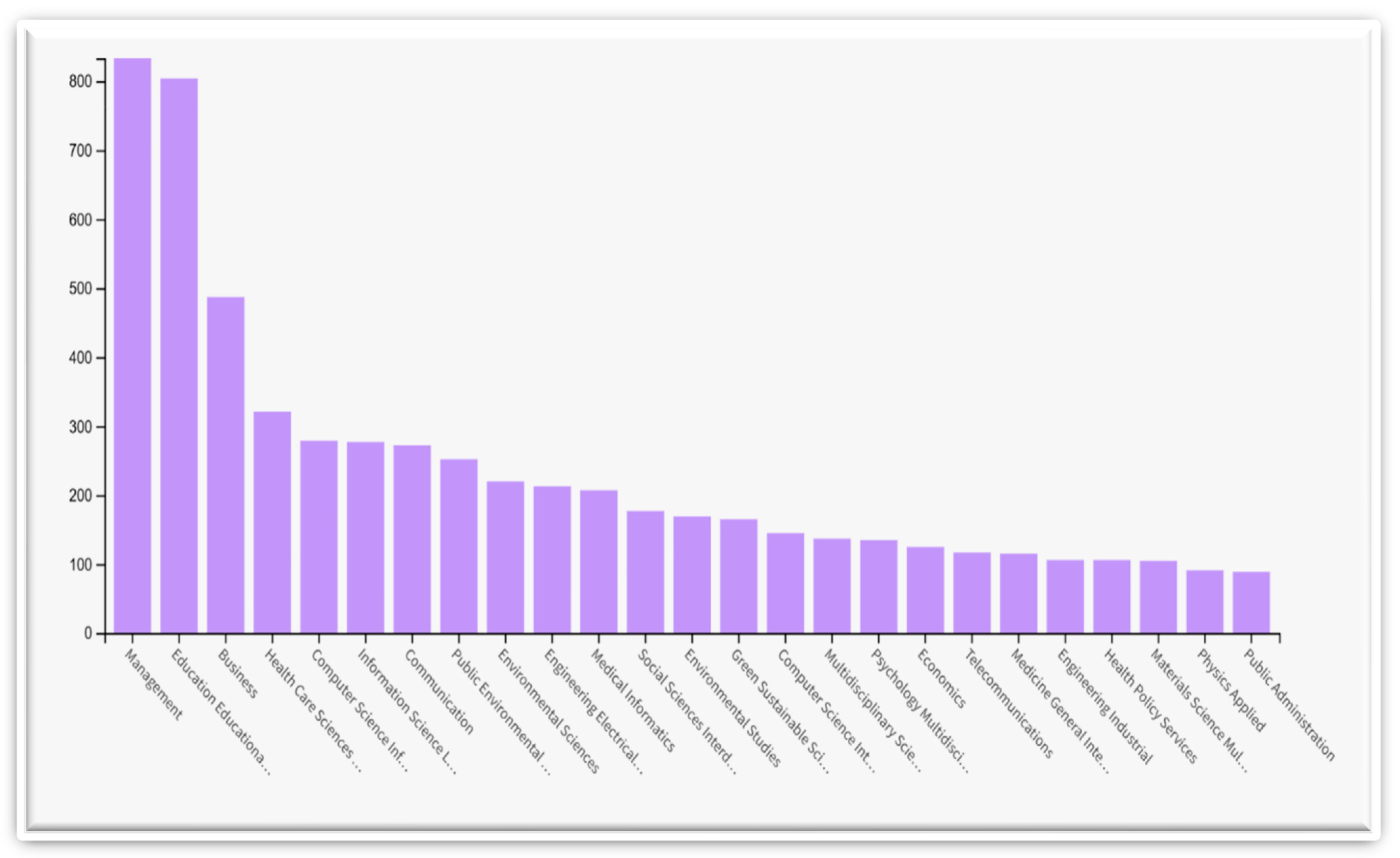
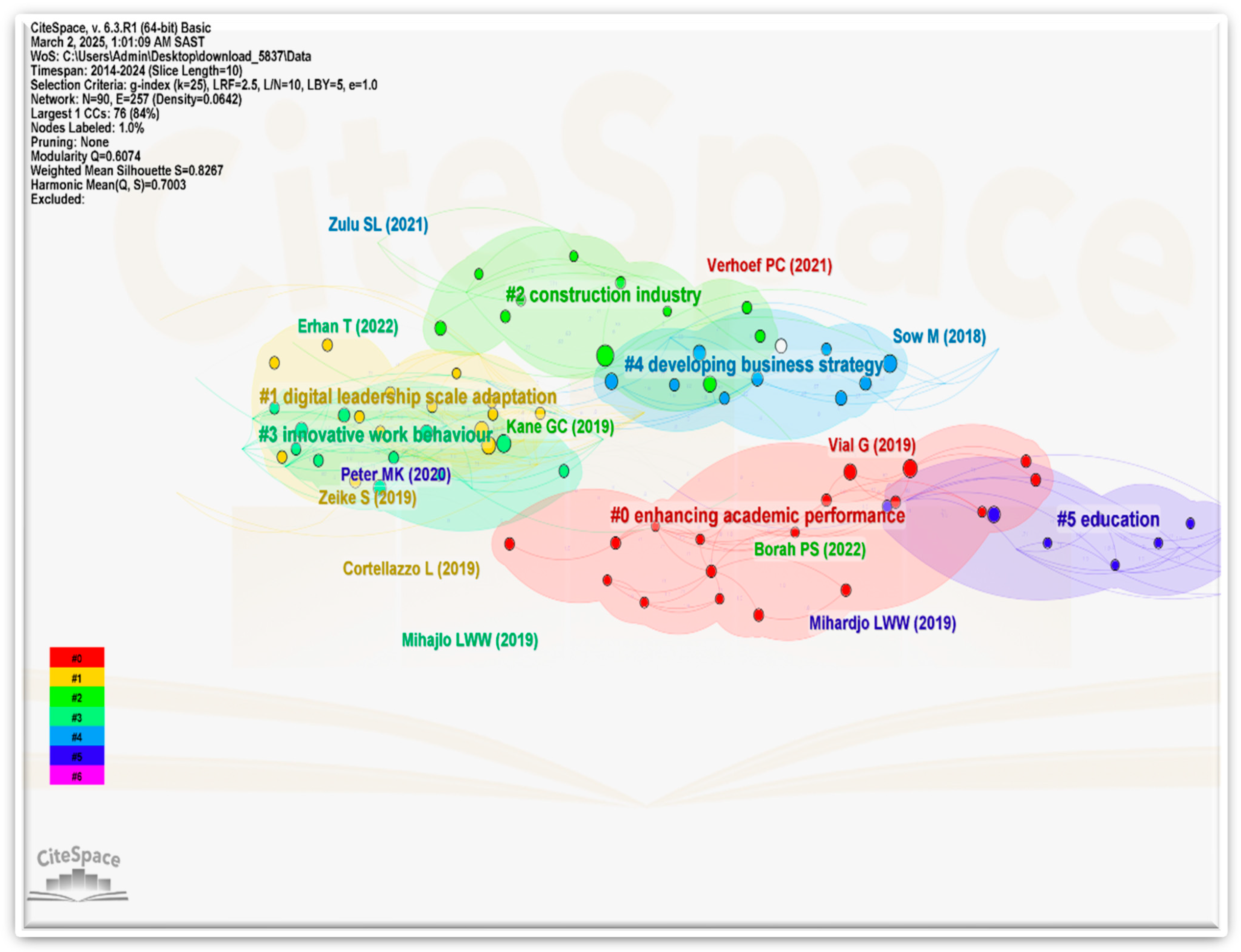

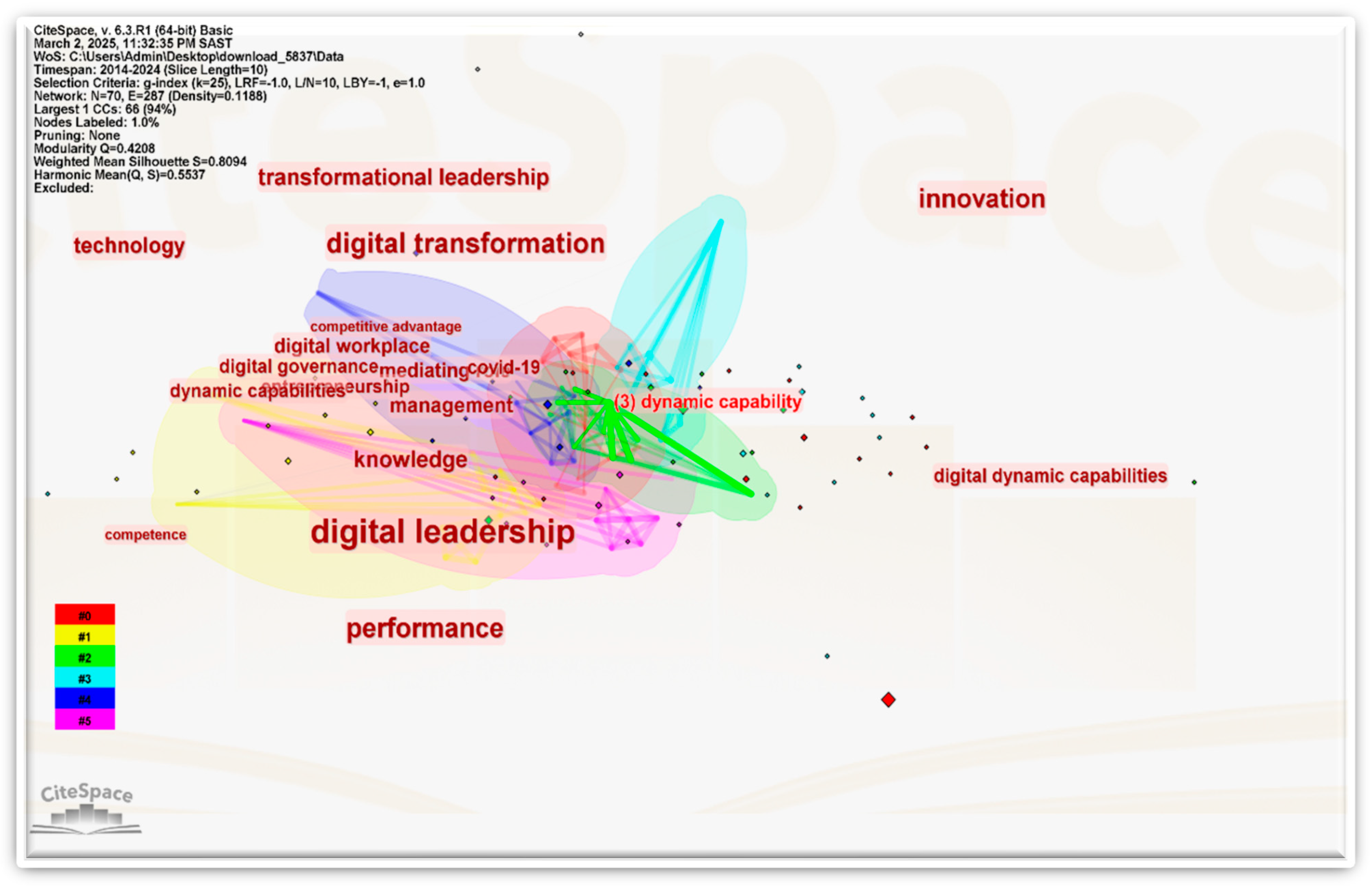

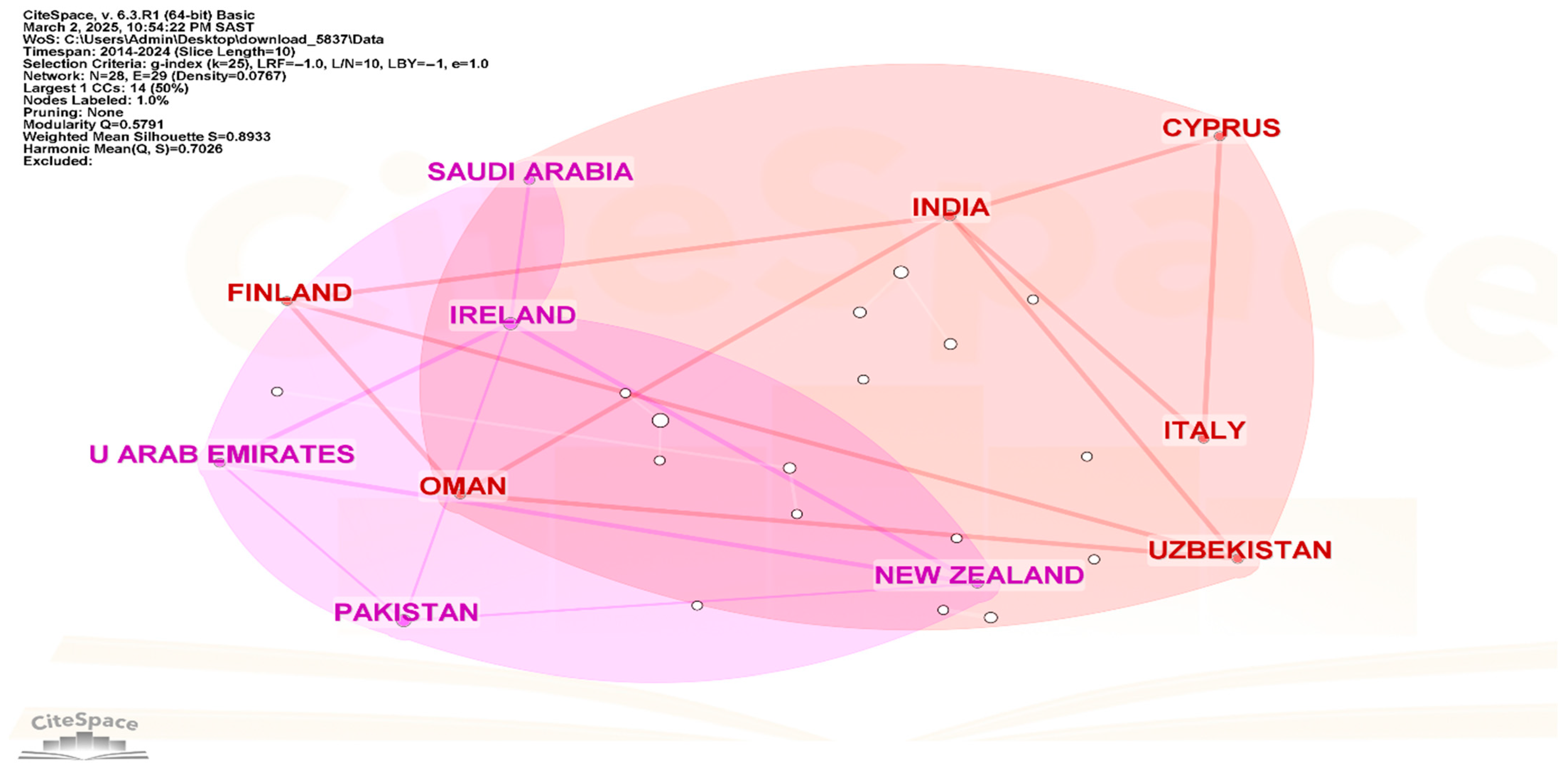
| Citation Counts | Degree | Sigma | Centrality | Node Name | Cluster ID |
|---|---|---|---|---|---|
| 2 | 5 | 1.00 | 145 | Zulu, Sambo Lyson | 5 |
| 1 | 5 | 1.00 | 124 | Papadakis, Stamatios | 0 |
| 1 | 5 | 1.00 | 135 | Yirci, Ramazan | 0 |
| 1 | 5 | 1.00 | 132 | Demirkol, Murat | 0 |
| 1 | 5 | 1.00 | 123 | Kocabas, Ibrahim | 0 |
| 1 | 5 | 1.00 | 89 | Karakose, Turgut | 0 |
| 1 | 4 | 1.00 | 146 | Ozdemir, Tuncay Yavuz | 0 |
| 1 | 4 | 1.00 | 256 | Hoeborn, Gerrit | 1 |
| 1 | 4 | 1.00 | 234 | Yanto, Heri | 2 |
| 1 | 4 | 1.00 | 201 | Zia, Ayesha | 3 |
| Citation Counts | Degree | Centrality | Node Name | Sigma | Cluster ID |
|---|---|---|---|---|---|
| 20 | 62 | 1.20 | digital leadership | 1.00 | 0 |
| 9 | 30 | 0.10 | digital transformation | 1.00 | 2 |
| 5 | 26 | 0.09 | performance | 1.00 | 2 |
| 5 | 24 | 0.05 | innovation | 1.00 | 2 |
| 4 | 17 | 0.02 | transformational leadership | 1.00 | 4 |
| 3 | 16 | 0.02 | dynamic capability | 1.00 | 2 |
| 3 | 15 | 0.01 | capability | 1.00 | 3 |
| 3 | 13 | 0.16 | communication | 1.00 | 1 |
| 2 | 12 | 0.02 | knowledge | 1.00 | 5 |
| 2 | 11 | 0.01 | technology | 1.00 | 1 |
| Citation Counts | Degree | Centrality | Node Name (Institution) | Sigma | Cluster ID |
|---|---|---|---|---|---|
| 2 | 6 | 0.04 | National University of Sciences and Technology—Pakistan | 1.00 | 0 |
| 2 | 5 | 0.04 | Ollscoil na Gaillimhe-University of Galway | 1.00 | 0 |
| 2 | 3 | 0.02 | University College Cork | 1.00 | 0 |
| 2 | 3 | 0.00 | Usak University | 1.00 | 4 |
| 2 | 3 | 0.00 | Leeds Beckett University | 1.00 | 9 |
| 1 | 3 | 0.00 | IBM USA | 1.00 | 1 |
| 1 | 3 | 0.00 | Indian Institute of Management (IIM System) | 1.00 | 2 |
| 1 | 3 | 0.00 | Indian Institute of Management Ranchi | 1.00 | 2 |
| 1 | 3 | 0.00 | Dumlupinar University | 1.00 | 3 |
| 1 | 3 | 0.00 | North Carolina State University | 1.00 | 1 |
| Citation Counts | Degree | Centrality | Node Name | Sigma | Cluster ID |
|---|---|---|---|---|---|
| 3 | 9 | 0.31 | PAKISTAN | 1.00 | 1 |
| 3 | 4 | 0.07 | IRELAND | 1.00 | 1 |
| 2 | 6 | 0.13 | INDIA | 1.00 | 0 |
| 1 | 4 | 0.00 | UZBEKISTAN | 1.00 | 0 |
| - | 4 | 0.00 | FINLAND | - | 0 |
| - | 4 | 0.00 | OMAN | - | 0 |
| - | 3 | 0.00 | UNITED ARAB EMIRATES | - | 1 |
| - | 3 | 0.00 | NEW ZEALAND | - | 1 |
Disclaimer/Publisher’s Note: The statements, opinions and data contained in all publications are solely those of the individual author(s) and contributor(s) and not of MDPI and/or the editor(s). MDPI and/or the editor(s) disclaim responsibility for any injury to people or property resulting from any ideas, methods, instructions or products referred to in the content. |
© 2025 by the authors. Licensee MDPI, Basel, Switzerland. This article is an open access article distributed under the terms and conditions of the Creative Commons Attribution (CC BY) license (https://creativecommons.org/licenses/by/4.0/).
Share and Cite
Olabiyi, O.J.; Vuuren, C.J.v.; Du Plessis, M.; Xue, Y.; Zhu, C. Digital Academic Leadership in Higher Education Institutions: A Bibliometric Review Based on CiteSpace. Educ. Sci. 2025, 15, 846. https://doi.org/10.3390/educsci15070846
Olabiyi OJ, Vuuren CJv, Du Plessis M, Xue Y, Zhu C. Digital Academic Leadership in Higher Education Institutions: A Bibliometric Review Based on CiteSpace. Education Sciences. 2025; 15(7):846. https://doi.org/10.3390/educsci15070846
Chicago/Turabian StyleOlabiyi, Olaniyi Joshua, Carl Jansen van Vuuren, Marieta Du Plessis, Yujie Xue, and Chang Zhu. 2025. "Digital Academic Leadership in Higher Education Institutions: A Bibliometric Review Based on CiteSpace" Education Sciences 15, no. 7: 846. https://doi.org/10.3390/educsci15070846
APA StyleOlabiyi, O. J., Vuuren, C. J. v., Du Plessis, M., Xue, Y., & Zhu, C. (2025). Digital Academic Leadership in Higher Education Institutions: A Bibliometric Review Based on CiteSpace. Education Sciences, 15(7), 846. https://doi.org/10.3390/educsci15070846









